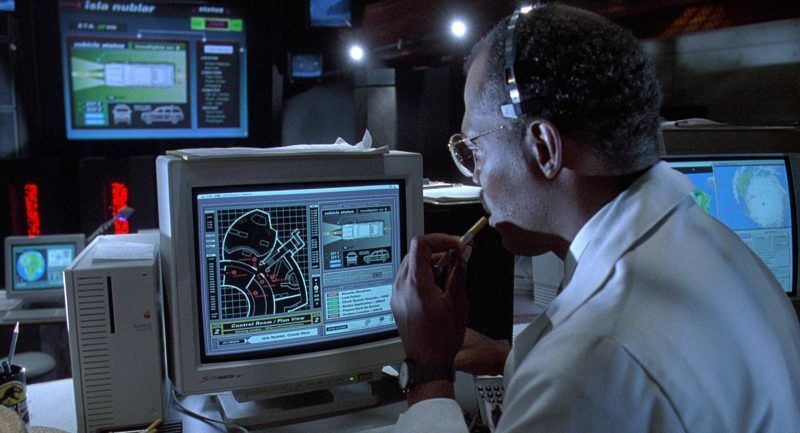
The crop of personal computers available in the last decade of the 20th century were markedly faster, more capable, and more connected than their primitive ancestors. Clock speeds and transistor counts were rapidly increasing, and the decreasing cost of memory and storage was opening up new avenues for the personal computer to evolve from an expensive desk accessory into a tool for multimedia and professional graphics design.
In 1991, the Intel i486DX was one of the hottest processors on the market—literally. It was one of the first that all but required a heatsink, and a cooling fan was a good option for processors with higher clockspeeds. But for Apple, the PowerPC architecture was still below the horizon, leaving just one choice for high-performance Macintosh computers in the early 90s: the Motorola 68040 microprocessor.
What a beast. The ‘040 was a substantial upgrade over the ‘030 that had previously been used by Apple. It featured 1.2 million transistors, over four times as many as its predecessor. This processor increased the L1 cache size by a factor of eight to 4096 bytes, and it was the first 68k processor to have an on-board floating-point unit (FPU). While not without its drawbacks, the ‘040 processor was an obvious candidate for Apple’s next line of premium workstations at time. And this line would become known as “Quadra,” starting with the Quadra 700 and 900 models in late 1991.
While the floor-standing tower Quadra 900 was the crème de la crème in regards to overall performance and upgradability, its physical size and price tag were a barrier to entry for some. Its desktop size brother, known as the Quadra 700, was arguably the more impressive of the two computers anyway. After all, it was the Quadra 700 that featured in Apple’s Quadra television commercial and went on to appear prominently in a certain Speilberg dinosaur-action blockbuster.
Both computers were marketed towards professionals looking for a home or office-based workstation-class computer, ideal for scientific, business, and design applications.
Fast forward nearly 30 years, and today the Quadra 700 is one of the most sought after vintage Macintosh computers. Part of this may be due to that supporting role next to Jeff Goldblum, but there are other reasons, too.
The 700 is one of the few vintage Apple computers to use tantalum capacitors on the logic board, rather than electrolytic. The latter capacitors inevitably leak electrolytic fluid, causing electrical instability and corroding traces on the logic board. Tantalum capacitors have no electrolytic to leak and are not prone to failure.
Other quality-of-life improvements over its peers include the Quadra’s dedicated video RAM (VRAM), which is coupled tightly with the processor. A direct access to the frame buffer significantly improves video performance on the Quadra over other models like the IIsi. Memory expansion capacity was also improved, with the 700 supporting up to a total of 68MB of RAM. This amount was not possible at launch, as the SIMMs that supported this memory density would take several more months to be developed. VRAM could be upgraded to as much as 2MB.
I know all this because I remain a hopeless computer tinkerer who happened to come across a Quadra 700 around the start of 2020. Unlike my road test of the IIsi for Ars back in 2018, the Quadra 700 presented a tantalizing opportunity to really push the limits of early 90s desktop computing. Could this decades-old workhorse hold a candle to the multi-core behemoths of the 2020s? The IIsi turned out to be surprisingly capable; what about the Quadra 700 with its top-shelf early ‘90s specs?
-
Beware, some gear lust may result from reading about and look at a Quadra 700 in 2020.Chris Wilkinson
-
Still quite a handsome bit of hardware for the home desk.Chris Wilkinson
-
How long before Apple at least does some one off vintage styled hardware? How has this not happened in the last five years?Chris Wilkinson
Project Quadra 2020 (or, how I spend my time during a pandemic)
The 700 was sold to me in working condition, but otherwise “as-is.” There were a few items that could require immediate attention, not least being the floppy drive. Sticky, hairy, dirty—these were all common symptoms for Apple floppy drives with their doorless design even then. Over the years, this design decision naturally allowed all manner of dust and grime to build up. A full restoration of the drive would have to wait for another day, though, as I had plenty of spare drives to use in the meantime.
Half-assembled, I confirmed that the Quadra powered up just fine. Apple recommends not running the 700 for longer than 20 minutes with the case off, otherwise the passively cooled 68040 processor melts down. Not the best design, but it works fine with the case shut.
Vintage Macs usually require a full teardown and capacitor replacement before they can be safely powered up. The aforementioned electrolytic fluid and underperforming capacitors can cause all sorts of electrical havoc if a thorough cleaning and capacitor replacement isn’t performed. With the tantalum capacitors on the logic board, the only real concern left was the power supply. A good dusting with compressed air blew out most of the large chunks of dust. The larger capacitors inside the power supply will need replacing eventually, too.
At this point, we had a working system with a modest amount of RAM and VRAM, a decently sized hard drive, and three empty expansion slots. As far as restorations go, everything went very smoothly. With no leaking capacitors or failing lithium batteries to deal with, the Quadra was in tip-top shape. This would be more than adequate for playing a few rounds of Bolo.
I think we can do better, however.
